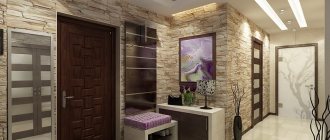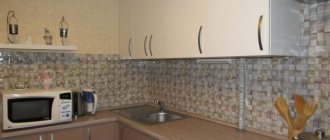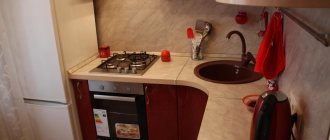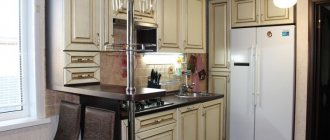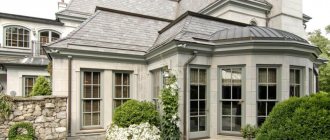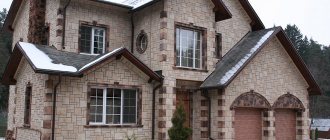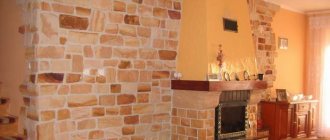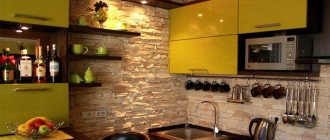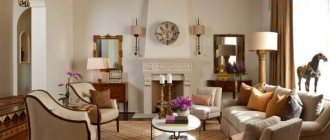Decorative stone has long been part of the lives of ordinary people. This seamless material, reminiscent of natural stones in its appearance, is used not only for the exterior decoration of houses, it has become a part of many indoor interiors. Finishing stone is often called artificial. In fact, natural ingredients are used to make coatings that imitate natural stones: gypsum, sand, clay, cement, crushed rock waste, water.
Kitchen cladding with cement-based artificial stone
Cement-based finishing materials are considered the most reliable and durable. The strength of the cladding largely depends on the brand of cement. The higher it is, the stronger the product. If we compare the strength of sedimentary rocks, such as limestone or sandstone, with their imitation based on M500 cement, then natural types of stone will lose in terms of resistance to mechanical damage to artificial ones. The facing material with a cement base does not absorb moisture and does not suffer from temperature changes. It is suitable for use in rooms with high humidity and for finishing building facades. The disadvantage of cement blocks is their heaviness. Not every wall can withstand cement finishing cladding.
Nevertheless, finishing materials made of cement are often used for interior work. Especially in kitchen areas, for covering the surface of walls with imitation brickwork, shell rock, and wild stone.
Beautiful finish
Today, finding a photo of a stone kitchen on the Internet is not difficult. Various photographs clearly demonstrate the beauty of this material, which is highly popular.
It is advantageous to choose it due to its resistance to various influences. The stone will retain its original attractive appearance for a very long time due to its reliability and durability.
The reasons for the high popularity of the stone include the ability to successfully fit it into different interior styles. At the same time, suitable textures and shades are selected, with which there will be no difficulties thanks to the widest range of varieties offered for sale today.
There is an extensive list of interior styles in which the use of stone is allowed:
- These include classic ones that have not gone out of fashion for a long time.
- When planning a kitchen in the Provence style, stone is also often used.
- It will be appropriate in such an interesting direction as country music. Together with this decoration, you can create a very cozy kitchenette, decorated in Scandinavian style.
- And this is not a complete list, because many other interesting directions can be named, which the appropriate use of stone in the required quantity will help to reveal.
The stone will delight you with its remarkable aesthetic properties. Thanks to its decorative effect, it becomes an appropriate addition to the interior.
Kitchen cladding with artificial flexible stone
This cladding looks like ordinary wallpaper. The cladding is based on a durable fabric base, onto which polymer binders mixed with dust and fine sandstone chips are applied. The industry has launched the production of flexible cladding in the form of wide strips and small tiles, which creates additional convenience when gluing surfaces with curved and rounded shapes.
Coloring option
In bulk
It is considered the most practical and best way. In this case, coloring pigments in powder form, which are used for concrete, are added directly to the gypsum solution. Thus, you receive a product that is painted from the inside. When cutting or chipping, you will not see the white base.
A beige or yellow solution is best, and in polyurethane form, parts of the stones can be painted with liquid pigments using a brush.
For this:
- take ½ tsp. color (pigment);
- add 200 ml of water;
- add 200 ml of any acrylic primer.
When the stone has set, remove it from the mold and dry it, and after laying it on the surface, apply a matte water-based varnish to it.
This option for painting decorative gypsum stone is the most effective and almost all manufacturers use it. That’s why we can see these kinds of products in stores. The disadvantage of this method is the rough and unnatural painting, which can be observed at close range.
By making gypsum artificial stone yourself, you have the opportunity to work on naturalness by carefully painting parts of the stones in the mold. Of course, no one will do this on an industrial scale, otherwise the price will increase significantly.
Below we will propose another painting technology that will help make a product from gypsum tiles that is more similar to natural stone. You will learn how to paint artificial stone so that it has the same natural veining and color scheme as natural stone.
Surface
Prepare:
- water-based (coloring pigment);
- water;
- spray or brush.
The instructions are simple - you need:
- add a coloring pigment to the water, you can even add several at once;
- dip a brush into the solution;
- saturate gypsum tiles with it.
Artificial gypsum stone has unique properties of developing shades that are similar to natural ones due to the absorption of tinted water.
In order to give gypsum stone the desired shade and color, you do not need to have an artistic education. Dip the brush into the colored water and paint the stone as you see fit.
Then you can tint some with a dark solution consisting of color pigment and water. You shouldn’t think too much about the palette, since each gypsum tile, even with the same texture, will absorb the solution differently, which will allow you to create an individual pattern each time.
You can also use any sprayers for work, for example:
- spray gun;
- sprayer for glass cleaning products.
Pour paint diluted with water-based tinting paste into a container and spray it onto the gypsum tiles. It is better to use several of these sprayers with different colors in your work so that you can treat different places on the stone. Then the painting process will be better and faster.
The advantage of painting yourself
- The store offers artificial stone in standard colors and with obvious artificial coloring. It does not have natural colored veins, like natural ones.
- You can purchase products in white or plain beige, glue them to the walls, and then paint them on the spot with water and coloring pigments diluted in it. This method makes masonry much more natural. (See also article.)
- Once the plaster stone has dried and become faded and pale in appearance, open it with any silky matte or matte varnish. This way you can restore the color saturation of the product, strengthen and protect its surface.
- If you want to achieve a “wet” effect on artificial stone, use varnishes, but be aware that this will slightly reduce the naturalness of the material.
Kitchen cladding with artificial stone with acrylic resin base
The composition of such cladding includes crushed waste marble, granite, and white clay. It binds all the components of different types of synthetic resins obtained by copolymerization of acrylic monomers. Stones with a base of acrylic resins are used to make countertops and window sills. Their surface has good performance qualities and is resistant to various types of loads, moisture, and high temperatures. Thick acrylic sheets are used for cladding work surfaces, thin ones are used for finishing wall fragments and kitchen aprons.
Key Features
Every housewife dreams of a beautiful, functional and cozy kitchen. You can create a unique and original design using natural wild or artificial finishing stone, one of the most durable and reliable materials. The decor is durable, stable, chemically neutral, insensitive to moisture and temperature changes. Its undoubted advantage is environmental safety. Of course, such luxury doesn't come cheap. But there are many finishing options, and each is unique. You can cover the walls completely or in separate islands, skillfully combining them with other materials.
Kitchen cladding with artificial stone based on quartz
Decorative stone consists of 90-95% quartz, and binds the vein mineral with synthetic polyester resins. Quartz agglomerate coatings are wear-resistant and durable. They are used not only for covering kitchen surfaces, but also for making window sills, plumbing fixtures, countertops, and flooring. The coating is not afraid of water, acids, alkalis, and there are no conditions for the development of pathogenic flora. The hard surface of decorative stone has a uniform structure, is resistant to various types of contamination, and is easy to maintain.
Stone and brickwork
Under the stone
It has many varieties, including cladding, installing stones on a flat surface with an adhesive mixture.
A flat view of the kitchen wall is laid with a die, and it is necessary to select and lay it so that there are no obvious voids. Volumetric masonry made of thin stone can be laid smoothly or in relief.
Under the brick
Stone in the kitchen can be laid using American, English, or Flemish bonding.
In the photo, the wall in the work area is lined with granite and highlighted with a niche made of brickwork to resemble a rustic stove.
The “Castle” cladding imitates the masonry of a medieval fortification. A rectangular identical stone is laid according to the “Shahriar” type.
The photo shows brickwork in a modern-style kitchen, where brick performs not only a decorative, but also a practical function.
Kitchen cladding with porcelain stoneware
Porcelain tiles are considered strong artificial stones that are resistant to mechanical damage. Therefore, it is used for tiling work areas of kitchens. Window sills, countertops, and floors are made from porcelain stoneware.
Advantages of decorative stones for kitchen cladding over natural stones
Artificial decorative materials imitating natural ones are practical, easy to install and maintain. Their structure does not contribute to the appearance of mold and is not susceptible to damage by fungus or other pathogenic flora. Therefore, it is suitable for finishing work in bathrooms and kitchens, places with high humidity.
In addition, they have a wide range of variations in the front surface. This is an imitation:
- sawn blocks with no grinding in any part of it;
- untreated marble, granite or quartz natural rocks;
- boulders or small, rounded smooth stone;
- brickwork.
The artificial finishing material in the form of tiles is similar in appearance to natural stones processed by grinding (granite, marble). Mosaics are made from artificial stone in a wide range of colors and structures.
Decorative coatings are strong, durable, resistant to fire, ultraviolet rays, changes in air temperature, and can be combined with materials made of wood, metal, and glass. The industry produces a wide palette of colors of finishing materials with glossy, matte, textured surfaces. The decorative material is easy to install. Its attachment to the walls is reminiscent of laying ceramic tiles.
Decorative stones are much lighter in weight than natural stones, so they do not create excessive load on the walls or deform their surface. The main thing when decorating with stone is not to overdo it. You should not cover the entire surface of the walls that is free from other materials, so as not to end up looking like a stone cave.
Cladding with artificial stone imitating natural stone is combined with wall covering with many finishing materials, such as wallpaper, plastered surfaces, tiles, wood, and plaster. Combination options can be selected endlessly.
When decorating with artificial stone, it is necessary to take into account the parameters of the room, the height of the ceilings, the stylistic direction in the design and furnishings, and the illumination of the walls with natural light. For small kitchens, decorative stone cladding is used to fragmentarily highlight door and window openings, paintings, and one or more corners.
Design methods
Several walls
You can cover it with stone if the kitchen is medium to large in size. You can make adjacent or parallel walls from boulders in combination with wood or plaster.
One wall
It will attract attention; it is better to decorate a wall free of furniture with stone, for example, near the dining room group.
Part of the wall
Part of the wall can be lined with stone if it is a small kitchen. The part can be upper, lower, or combined with wallpaper.
Stone panel
Framed or edged, stone panels provide decor that can be replaced and moved.
Niches or shelves
Niches or shelves trimmed with stone do not take up much space and create a unique design.
Apron
It can be made from natural or artificial stone, the main thing is to protect it from the formation of mold and mildew due to high humidity near the sink. The stone can be flat, imitating a marble slab, brick, laying with a die is suitable.
Corners, doorways, arches
Corners, doorways or arches in the kitchen can be completely or partially covered with bricks of different sizes, thereby strengthening them.
The photo shows square columns that serve as the entrance to the kitchen, where the apron is lined with pebbles and the countertop is made of granite. The unity of different breeds is harmoniously combined in one interior.
Kitchen interiors with imitation natural stones
Finishing kitchen surfaces with artificial stone does not have statistical electricity, which means it does not attract dust. Its original appearance has not changed for many years. The surface does not require special care. It is enough to wipe it with a dry or damp cloth from time to time. This finishing of kitchen surfaces suits the design of many interiors.
Care
Despite its sophistication and extraordinary aesthetics, decorative stone is very easy to maintain. Actually, all caring procedures come down to wiping surfaces from dust. Some finishes are sold already varnished. Thanks to this, the decor can be washed just like regular tiles.
There are the following types of care:
- Dry (using a static broom);
- Vacuum cleaning;
- Wet cleaning.
Particularly conscientious and diligent housewives prefer wet cleaning using detergents. But this is truly necessary only when the working area of the kitchen is lined with stone. Coated with a special primer or varnish, the decorative stone perfectly withstands all experiments associated with wet cleaning.
Kitchen interiors with artificial stone in Provence style
The Provence style came to us from France, bringing with it the good taste of many generations. With it, even a small city kitchen acquires coziness, comfort, an atmosphere of hospitality, and a unique style. Provence style saturates the space with an abundance of color, light, pastel tones. It is distinguished from others by antique furniture with signs of wear, wooden carved objects with forged elements, copper and bronze accessories, and an abundance of living plants on the floor and walls.
Color solution
White
White (quartzite, granite, marble, brick) is suitable for Scandinavian, modern classic kitchen style, expands the space and combines with black, dark brown flooring and wood paneling.
Black
It will add charm to the kitchen, without being too easily soiled. Suitable for a spacious room or in combination with white, brown.
Grey
Gray color (slate, granite, quartzite, marble) will become the background for a bright set, combined with neutral colors.
Red
Red (brick, onyx, granite) attracts attention, is suitable for creating luxury, combined with a red countertop, dark wood.
In the photo, red brick looks organically in a modern interior along with lighting, a glossy facade and a marble floor.
Brown
Brown color accompanies almost all natural wood, combines with wood finishes, adds coziness to the kitchen, and is suitable for any style.
Beige
It is better to combine beige for wall design with dark colors of other finishes, or make it the background for a visually accent set.
Color
Colored with tints, veins, a combination of different colors (pebbles) gives a unique perception of the kitchen, a unique wall will look original and attract attention.
Kitchen interiors with artificial stone in Country style
Country style appeared in the 20-30s of the last century. It is distinguished from others by its naturalness and comfort, inspired by rustic motifs. In each of the countries, it absorbed only their inherent flavor, received many different directions, consonant with the national culture of a particular country. The country style of different countries is united by the unity of color solutions, consisting of a natural palette of color compositions. In country style, there are only colors that are in tune with nature without bright colorful clutter. No glossy surfaces, chrome parts in door fittings or kitchen cabinet parts.
When decorating kitchens in a rustic style, only real wood furniture is used, wall elements are decorated with natural or imitation stone, and plain rustic ornaments.
Decorative tiles
A durable coating for kitchen finishing, resistant to moisture, alkalis, and temperature. Outwardly, these are not single blocks, but several connected into a finished composition on a single surface. Due to this, installation is faster, there is no need to select a harmonious combination, the tiles are designed taking into account the nuances. It is used to create aprons, vertical surfaces, trim fireplaces, columns, bar counters and islands. Marble decor and porcelain stoneware slabs are laid on the floor, creating an elegant interior.
